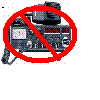| Author |
Message |
    
Joey_migs
Member
Username: Joey_migs
Post Number: 69
Registered: 9-2009
| | Posted on Wednesday, December 23, 2009 - 11:11 am: | 


|
I just passes my Extra exam, and am hoping the 2 old weeks or so for my call to be included in the FCC ULS (maybe longer cause the holidays)goe fast. In the meantime I am looking to build a inverted V trapped for 20, 40 and 80 meters (and if possible 160.) My question is how high must the center support be so as the Antenna will produce a decent pattern across these aforementioned bands? NOTE: the surrounding ground is moist and has a relatively low resistant so ground loses are an issue.
Thanks, in Advance, and Happy Holidays
Joe |
    
Ironmike
Junior Member
Username: Ironmike
Post Number: 31
Registered: 6-2007

| | Posted on Wednesday, December 23, 2009 - 6:18 pm: | 


|
I've always understood 35 feet to be a minimum, although Ive worked 40-10 as low as 6 feet. Shoot for 35 feet and you'll be ok. |
    
Tech237
Moderator
Username: Tech237
Post Number: 1275
Registered: 4-2004

| | Posted on Thursday, December 24, 2009 - 10:46 am: | 


|
In theory for 80m it needs to be 20m or about 66ft above RF ground. As in most cases, this is not feasible go for as high as possible.
Tech237
N7AUS
Chipmonks roasting on an open fire
Hot sauce dripping from their toes.
|
    
Joey_migs
Member
Username: Joey_migs
Post Number: 73
Registered: 9-2009
| | Posted on Saturday, December 26, 2009 - 9:18 am: | 


|
I think I will install the MFJ-1910
POLE, 10M TELESCOPIC FIBRE GLASS (33 ft) on top 25 ft roof via chiminy mount, should achieve about 54 ~ 55 ft. Should I trap the 160 or 80 meter on the respective Vee sides or will the lack of harmonic suppression be an issue
Thanks guys,
Joe |
    
Patzerozero
Senior Member
Username: Patzerozero
Post Number: 4752
Registered: 7-2004

| | Posted on Sunday, December 27, 2009 - 6:19 pm: | 


|
my long island house is too close to the road & my property is too narrow to run a conventional dipole wire in any configuration below 15 meters. par endfedz got me onto 20 & 40m, currently around 28' above the ground. i have a ct1ffu 32 meter endfed EZ wire that allegedly works real well even on 160m. a friend has one & it works real good on 80m, 160 he says works though he has nothing to compare it to, but swr is decent, at least. he inverted, L'd & zig-zagged his all at the same time & says he noticed little if any performance difference. hope to be able to fish mine through the tree branches before the leaves start growing. my par's work just fine! 20+ over S-9 this afternoon on 20m to 6 & 7 land, mexico & several stations in UK, italy, portugal & north africa. |
    
Funtimebob
Intermediate Member
Username: Funtimebob
Post Number: 253
Registered: 5-2002

| | Posted on Sunday, December 27, 2009 - 8:44 pm: | 


|
Joey, If you just upgraded your license you can use your current call with /AE and use your new privileges NOW instead of waiting for the FCC to post the upgraded call on the database
This post was brought to you By Umpire Cologne.
73 KD8DEY
|
    
Slugo4449
Intermediate Member
Username: Slugo4449
Post Number: 191
Registered: 7-2004
| | Posted on Friday, January 01, 2010 - 12:30 am: | 


|
Boy, Joey, what a great CW Call you have. It is posted with an extra 2X2 callsign on QRZ |
    
Barracuda
Intermediate Member
Username: Barracuda
Post Number: 338
Registered: 3-2003

| | Posted on Friday, January 22, 2010 - 7:25 pm: | 


|
As I understand it, about 1/2 wl (of lowest band) above ground is "the minimum" to make the antenna pattern come to its "proper" shape. However, the antenna will still work at at lower or higher altitudes. As you get closer to the ground you just start moving signal up to higher elevation angles and away from the horizon. Great if you want to talk NVIS, but not so great if you want to DX. |



